
Fornax is a constellation in the southern celestial hemisphere, partly ringed by the celestial river Eridanus. Its name is Latin for furnace. It was named by French astronomer Nicolas Louis de Lacaille in 1756. Fornax is one of the 88 modern constellations.

NGC 6240, also known as the Starfish Galaxy, is a nearby ultraluminous infrared galaxy (ULIRG) in the constellation Ophiuchus. It was discovered by French astronomer Édouard Stephan on 12 July 1871.
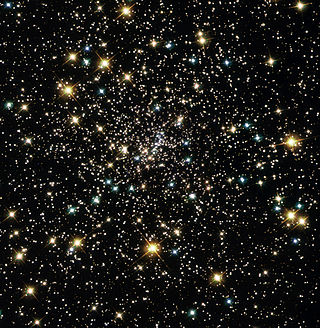
NGC 6397 is a globular cluster in the constellation Ara that was discovered by French astronomer Nicolas-Louis de Lacaille in 1752. It is located about 7,800 light-years from Earth, making it one of the two nearest globular clusters to Earth. The cluster contains around 400,000 stars, and can be seen with the naked eye under good observing conditions.

Messier 63 or M63, also known as NGC 5055 or the seldom-used Sunflower Galaxy, is a spiral galaxy in the northern constellation of Canes Venatici with approximately 400 billion stars. M63 was first discovered by the French astronomer Pierre Méchain, then later verified by his colleague Charles Messier on 14 June 1779. The galaxy became listed as object 63 in the Messier Catalogue. In the mid-19th century, Anglo-Irish astronomer Lord Rosse identified spiral structures within the galaxy, making this one of the first galaxies in which such structure was identified.

NGC 7793 is a flocculent spiral galaxy in the southern constellation of Sculptor. It was discovered in 1826 by Scottish astronomer James Dunlop. The galaxy is located at a distance of 12.2 million light years and is receding with a heliocentric radial velocity of 227 km/s. NGC 7793 is one of the five brightest galaxies within the Sculptor Group.

NGC 2787 is a barred lenticular galaxy approximately 24 million light-years away in the northern constellation of Ursa Major. It was discovered on December 3, 1788 by German-born astronomer William Herschel. J. L. E. Dreyer described it as, "bright, pretty large, a little extended 90°, much brighter middle, mottled but not resolved, very small (faint) star involved to the southeast". The visible galaxy has an angular size of 2.5 × 1.5 arcminutes or 3.24 × 1.81 arcminutes and an apparent visual magnitude of 11.8.

Arp 107 is a pair of interacting galaxies located about 450 million light-years away in the constellation Leo Minor. The galaxies are in the process of colliding and merging.

NGC 4639 is a barred spiral galaxy located in the equatorial constellation of Virgo. It was discovered by German-born astronomer William Herschel on April 12, 1784. John L. E. Dreyer described it as "pretty bright, small, extended, mottled but not resolved, 12th magnitude star 1 arcmin to southeast". This is a relatively nearby galaxy, lying approximately 72 million light-years away from the Milky Way. It is a companion to NGC 4654, and the two appear to have interacted roughly 500 million years ago. NGC 4639 is a member of the Virgo Cluster.
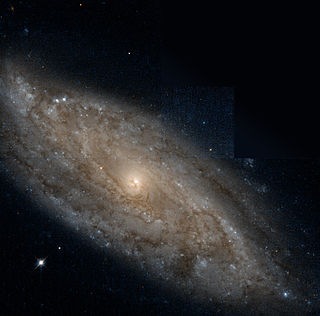
NGC 7314 is a spiral galaxy located in the southern constellation of Piscis Austrinus. It was discovered by English astronomer John Herschel on July 29, 1834. This is a nearby Seyfert (active) galaxy, located at a distance of approximately 54.6 megalight-years from the Milky Way. Since it appears to have detached spiral arm segments, it was listed in Halton Arp's Atlas of Peculiar Galaxies.

Markarian 231 is a Type-1 Seyfert galaxy that was discovered in 1969 as part of a search of galaxies with strong ultraviolet radiation. It contains the nearest known quasar. Markarian 231 is located about 581 million light years away from Earth, in the constellation of Ursa Major.
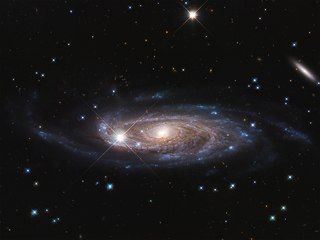
UGC 2885 is a large barred spiral galaxy of type SA(rs)c in the constellation Perseus. It is 232 million light-years (71 Mpc) from Earth and measures 463,000 ly (142,000 pc) across, making it one of the largest known spiral galaxies. It is also a possible member of the Pisces-Perseus supercluster.

NGC 4424 is a spiral galaxy located in the equatorial constellation of Virgo. It was discovered February 27, 1865 by German astronomer Heinrich Louis d'Arrest. This galaxy is located at a distance of 13.5 million light years and is receding with a heliocentric radial velocity of 442 km/s. It has a morphological class of SB(s)a, which normally indicates a spiral galaxy with a barred structure (SB), no inner ring feature (s), and tightly-wound spiral arms (a). The galactic plane is inclined at an angle of 62° to the line of sight from the Earth. It is a likely member of the Virgo Cluster of galaxies.

NGC 3675 is a spiral galaxy located in the constellation Ursa Major. It is located at a distance of circa 50 million light years from Earth, which, given its apparent dimensions, means that NGC 3675 is about 100,000 light years across. It was discovered by William Herschel in 1788.

NGC 3147 is a spiral galaxy located in the constellation Draco. It is located at a distance of about 130 million light years from Earth, which, given its apparent dimensions, means that NGC 3147 is about 140,000 light years across. It was discovered by William Herschel on April 3, 1785.

NGC 4800 is an isolated spiral galaxy in the constellation Canes Venatici, located at a distance of 95 megalight-years from the Milky Way. It was discovered by William Herschel on April 1, 1788. The morphological classification of this galaxy is SA(rs)b, indicating a spiral galaxy with no visual bar at the nucleus (SA), an incomplete ring structure (rs), and moderately-tightly wound spiral arms (b). The galactic plane is inclined to the line of sight by an angle of 43°, and the long axis is oriented along a position angle of 25°. There is a weak bar structure at the nucleus that is visible in the infrared.
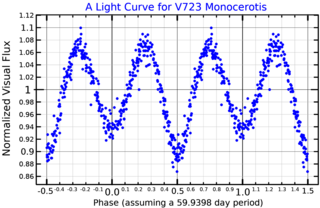
V723 Monocerotis is a variable star in the constellation Monoceros. It was proposed in 2021 to be a binary system including a lower mass gap black hole candidate nicknamed "The Unicorn". Located 1,500 light years from Earth, it would be the closest black hole to our planet, and among the smallest ever found.
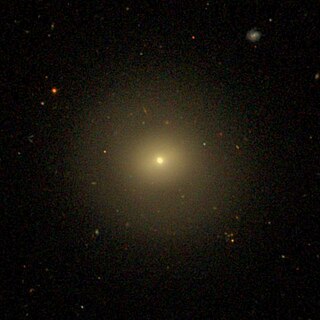
NGC 3599 is a lenticular galaxy located in the constellation Leo. It was discovered by William Herschel on March 14, 1784. The galaxy is located at a distance of 67 million light-years (20.4 Mpc) from the Sun. NGC 3599 is a member of the Leo II group of galaxies in the Virgocentric flow.

Markarian 1018, also known as UGC 1597, is a lenticular galaxy with a peculiar structure located in the constellation Cetus. It is located at an approximate distance of 607 million light years from Earth and has an apparent dimensions of 0.99 by 0.52 arcmin. It is classified as a change looking Seyfert galaxy and galaxy merger.


















